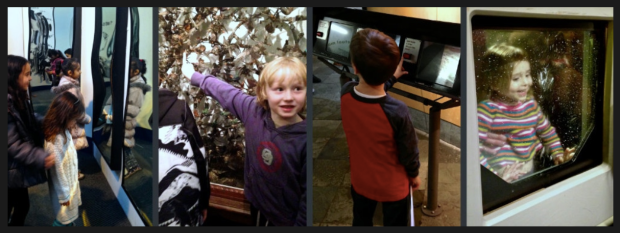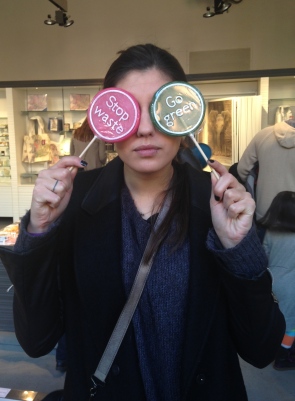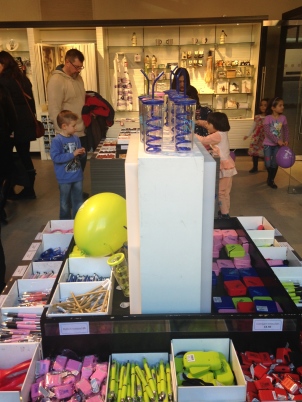One of the things I enjoy when having some free time, is visiting art exhibitions, galleries and museums. But this weekend, as I was reading Time Out magazine looking for a new exhibition to visit, I realised, that there is something about the word ‘museum’ that in a way made me ignore the specific event and continue with the rest of the arts-list. Do you know what I mean? As I started thinking about it, I believe that this occurred because of two reasons. Firstly Museums have varying aims, ranging from serving researchers and specialists to serving the general public. Moreover, they usually exhibit a collection of scientific, cultural or historic objects, rather than art pieces. And that brings me to my second point. As children, we all had been to a number of museum visits with our school, where we had to go around museums pretending to be interested where in fact we were all really bored and only waited for the time to pass so we could go home.
Because of that realisation, I decided to visit the Natural History Museum. It was not the first time thought. I have been to the one in New York and the one in London, but I was too young to remember them. So, I decided that it was a good opportunity to go again, and I am ver glad I did!
Where should I start from? Probably the first thing I noticed. The amazing architecture of the museum. It is hard to pass by the Natural History Museum and not be amazed by it. Inside and out the building is simply wonderful. From the outside, the detail in form and colour is noticeable. The combination of geometric and round shapes along with a combination of red, blue and brown is what in my opinion creates this softness and makes the museums look traditional. The entrance, simply makes you stop and observe the huge facade and high, spired towers. The beautiful rounded arches and grand entrance are a perfect example of Romanesque architecture. The Central Hall, is created to be grand and spacious enough to display large mammals such as whales, elephants as well as extinct animals such as Dinosaurs.
Extremely high ceilings, very large rooms and large stairs make the museum an extraordinary and kind of magical space. As you make your way inside the building, you move away from the traditional architecture which is replaced by more modern shapes and materials. In the Darwin space, glass is used both for large windows and for the colorful ceilings. The space is obviously designed based on the day light of the day, which is a part of the architectural design, as it comes in from the glass windows, doors and ceiling and lights the specific areas it was designed to light.
“There were many fascinating elements to explore: the sheer size of this valuable collection; the complexity of the scientists’ working environment, and their relationship to this collection – all bound together by the very contemporary concept of allowing the public to see behind the scenes” Anna Maria Indrio (Architecture team)
In this post, I will be focusing on the red zone, representing how the earth works. The reason why I chose to write about the specific department of the Museum is because it was the only department I was not that eager to visit and it turned out to be the best one. Everyone who has not been to the Natural History Museum is under the impression that it is a museum all about animals and dinosaurs. The ‘earth’ department though, is one that people should definitely visit.
Does the ‘earth’ zone still does not sound interesting? Take a look at its entrance
Scences from http://www.youtube.com/watch?v=N3eJoQJ-ADA & personal footage edited by me
This department explores the ever-changing planet, discovering the natural forces that shape it, the treasures we take away from it, our negative and positive effect to it and its place and role in the universe. All these things sound very confusing, difficult to understand and definitely not something children would enjoy learning about. But what makes it so interesting is the way it has been put together. The way the earth works, is one 100% science, but the designers of the museum have managed to transform it into art. Everything on the red zone is made from scratch in order to illustrate the ‘story of the earth’ better. The walls of every room are painted in different colours, have different textures and texts on them, either drawn or projected. Every little object tells a story, but it does not work if people don’t make it work. In other words, every piece of the room is interactive. You have to press a button, or pull a string in order to see it working.
To give a clearer example, the following photograph is showing elements of the earth: Gravity, Ice, Water, Wind, Life.
Even though this might be ‘boring’ as a fact, the museum has managed to present it in an interesting way. In order to illustrate gravity, the top of the object moves, as if its falling. In order to understand ice, you have to place your hand to the second object and you feel the cold. When you move closer to the third one, you can see and hear running water. If you put your hand inside the forth object you feel the wind, and just by looking at the fifth one, you see a mirror (thus your self) and YOU represent life. For me, all these details are what make every part of the red zone interesting. With this interaction, children get the opportunity to learn by playing games. Adults are also interested in these activities, and the truth is, that by watching something that creative and interacting with it, there are more chances that the information will stay in your head.
Do you still believe that it is impossible for young children to enjoy a day in the museum? Take a better look:
Finally, the museums gift-shop is definitely something interesting to visit after viewing the rest of the exhibition. A large variety of stuffed animals, puzzles, board games, jewellery and many many more is offered. Small toys and objects that will keep your children busy and happy and at the same time provide important information about the earth, living organisms and science. Moreover, a big collection of books about the environment, planets and animals is available with amazing imagery and simple language that is understandable by children. Finally, there is a unique section of environmentally friendly objects and sweets that all have a ‘green message’ included, such as the following lollipops with different logos such as ‘stop waste’ or ‘go green’.
I would definitely suggest to anyone to go to the Natural History Museum and spent the day learning more about our earth and all the living organisms that surround us, in a artistic, fun and interactive way. Parents should definitely take their children with them. You will be surprised by how much little kids will enjoy the specific museum and at the same time, how much they will learn. I wish I had counted how many times I heard children say ‘wowww’ during my time there.
For more information on the Natural History Museum, visit their website: http://www.nhm.ac.uk/
Thank you for reading,
Elli








Many thanks for the follow. I hope you will return again soon and often. My children and now grandchildren love the Museum of Natural History! Great photos!
Thank you very much for your comment
I’m really glad you put up this post. it was informative and the pictures are beautiful. I just moved to Maryland and I am excited about taking my daughters to see the Museum of Natural History and the Smithsonian Museum.
Thank you very much!
I appreciate the post. The information is detailed. The pictures are beautiful. I am going to take my daughters to the Smithsonian and Museum of Natural History. I’m already excited and this article compounds my excitement.
Thank you very much! Your daughters will definitely enjoy it
As a Washington, DC area dweller, I think this means I need to go to the Smithsonian again soon and keep my eyes more open than they’ve been in the past. I have an almost one year old, and I wonder if she might find something to interest her. Great post! Also loved your questions to the blogger you tagged in your previous post. Good food for thought!
Thank you very much! I believe that even though your one year old might not fully understand everything he/she will find it very interesting and enjoy it very much!
I am definitely going to go to the musuem, it looks great.
museum* 🙂
Thank you for your comment Rhea! You should definitely go it was super interesting and artistic
Reblogged this on Forget the Viagra, Pass Me a Carrot and commented:
As a child the words – why don’t you visit a museum used to strike fear into our hearts! We were outdoors kids with bikes and scrapped knees. Over the years I have visited many of the worlds best including the Smithsonian and have come to appreciate the conservation of our history from early man. This is a great piece and I wish that as a child I had visited more. Thanks Art Attack
Thank you very much for reflagging my post! Best, Elli
The Natural History is amongst my favorites here in California. I would love to visit yours in the future also! Thanks for sharing!
I wish you get the chance and visit the London NHM as well! Thank you for commenting!
I’ve been a few times. It’s a wonderful museum. If you go again, you should check out the photography exhibition there too. It’s a wonderful standard.
Thank you very much for your comment. I visited the photography exhibition as well, I found the images wonderful!
I did a post on it. I’ve been the last couple of years. I love them, though i don’t always agree with the winners ha http://alexraphael.wordpress.com/2013/12/12/gr8at-wildlife-photographer-of-the-year/
And of course outside is hideous at the moment, so being in a museum – with all those lovely big spaces – should be a treat in itself. I’ve even done the sleepover at the Science Museum with my kids (twice now – once with each daughter) and that is really good fun. The kids adored it too. Nicola http://homemadekids.wordpress.com
Sleepover? That sounds amazing, especially for children!